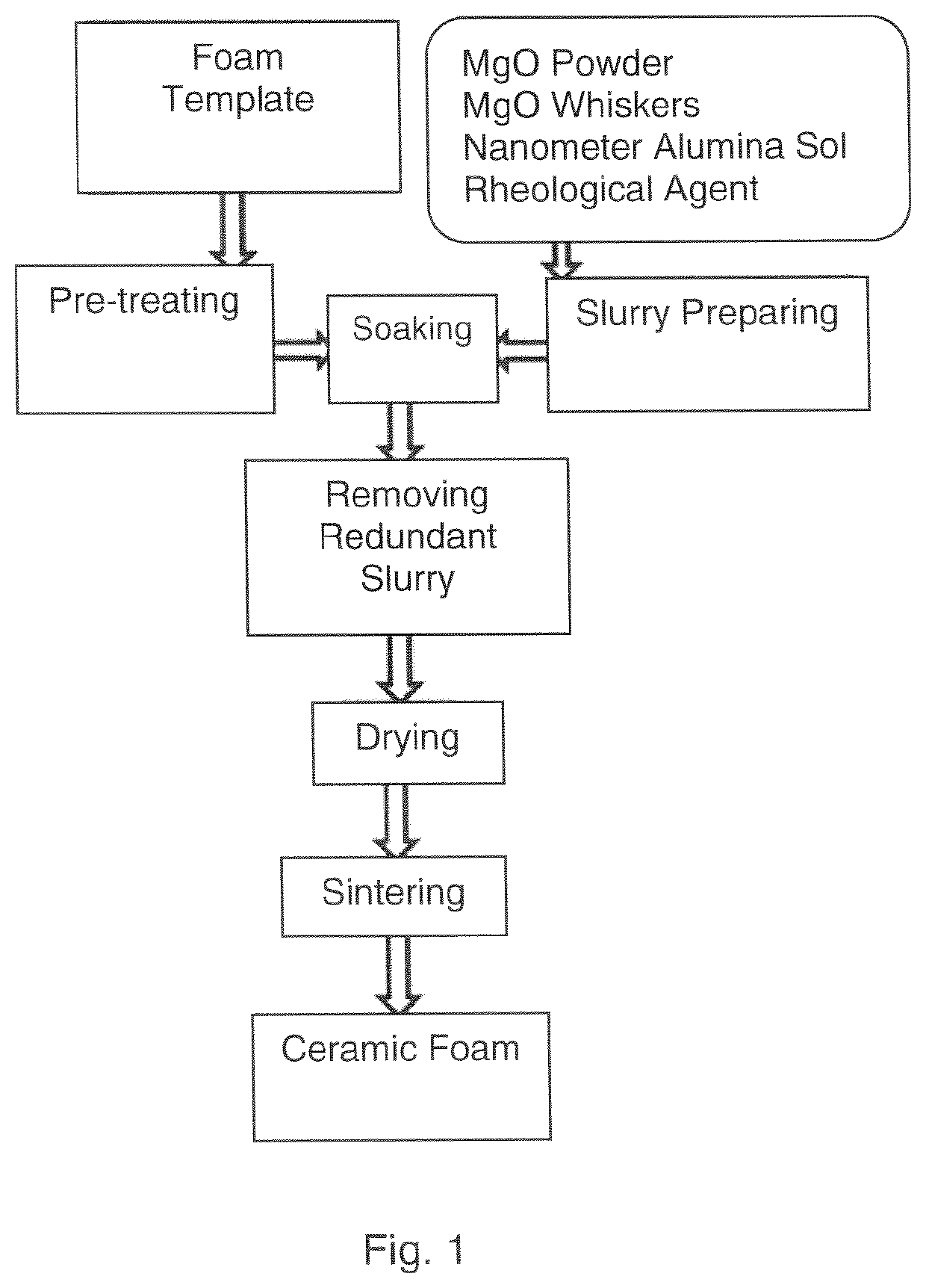Magnesium aluminate spinel reinforced magnesium oxide-based foam ceramic filter synthesized in situ from magnesium oxide whisker, and preparation method therefor
a magnesium oxide and ceramic filter technology, applied in ceramicware, filtration separation, separation processes, etc., can solve the problems of affecting the internal quality of the article, degrading the mechanical properties and anti-corrosion performance of the alloy, and affecting the mechanical properties of the same, so as to reduce the chemical stability, and avoid the damage to the chemical stability of ceramic foam
- Summary
- Abstract
- Description
- Claims
- Application Information
AI Technical Summary
Benefits of technology
Problems solved by technology
Method used
Image
Examples
example 1
[0038]With the ratio that magnesium oxide whiskers account for 1% by mass of ceramic powder, commercially available magnesium oxide whiskers and a fused magnesium oxide powder having a particle size of the order of 250 meshes (mean size d50 being 58 μm) were dosed to prepare a ceramic powder. With a mass ratio of 1:4 (urea formaldehyde resin: hydroxyethyl cellulose), a rheological agent was prepared by urea formaldehyde resin and hydroxyethyl cellulose.
[0039]With the following mass percentages, 15% nanometer alumina sol having a solid content of 20% (a commercial nanometer alumina sol having a pH value of about neutral was selected, the same for the following Examples), 0.8% rheological agent and the balance ceramic powder were dosed. In accordance with the ratio, the fused magnesium oxide powder was first added into a ball milling tank; the nanometer alumina sol, the rheological agent and a suitable amount of deionized water (the amount to be determined by the solid content of the ...
example 2
[0042]With the ratio that magnesium oxide whiskers account for 2% by mass of ceramic powder, commercially available magnesium oxide whiskers having a diameter of 2-5 nm and a length of 200-1000 μm and a fused magnesium oxide powder having a particle size in the order of 500 meshes (mean size d50 being 25 μm) were dosed to prepare a ceramic powder. With a mass ratio of 1:4 (urea formaldehyde resin: hydroxypropyl methyl cellulose), a rheological agent was prepared by urea formaldehyde resin and hydroxypropyl methyl cellulose.
[0043]With the following mass percentages, 20% nanometer alumina sol having a solid content of 25%, 1.5% rheological agent and the balance ceramic powder were dosed. In accordance with the ratio, the fused magnesium oxide powder was first added into a ball milling tank; the nanometer alumina sol, the rheological agent and a suitable amount of deionized water were prepared into a solution and then the magnesium oxide whisker powder was added therein, and ultrasonic...
example 3
[0046]With the ratio that magnesium oxide whiskers account for 1.5% by mass of ceramic powder, commercially available magnesium oxide whiskers and a fused magnesium oxide powder having a particle size of the order of 325 meshes (mean size d50 being 45 μm) were dosed to prepare a ceramic powder. With a mass ratio of 1:4 (urea formaldehyde resin: hydroxyethyl cellulose), a rheological agent was prepared by a urea formaldehyde resin and hydroxyethyl cellulose.
[0047]With the following mass percentages, 25% nanometer alumina sol having a solid content of 22%, 1.0% rheological agent and the balance ceramic powder were dosed. In accordance with the ratio, the fused magnesium oxide powder was first added into a ball milling tank; the nanometer alumina sol, the rheological agent and a suitable amount of deionized water were prepared into a solution and then the magnesium oxide whisker powder was added therein, and ultrasonic treating for 60 minutes to have the magnesium oxide whisker powder ...
PUM
| Property | Measurement | Unit |
|---|---|---|
| temperature | aaaaa | aaaaa |
| diameter | aaaaa | aaaaa |
| temperature | aaaaa | aaaaa |
Abstract
Description
Claims
Application Information
 Login to View More
Login to View More - R&D
- Intellectual Property
- Life Sciences
- Materials
- Tech Scout
- Unparalleled Data Quality
- Higher Quality Content
- 60% Fewer Hallucinations
Browse by: Latest US Patents, China's latest patents, Technical Efficacy Thesaurus, Application Domain, Technology Topic, Popular Technical Reports.
© 2025 PatSnap. All rights reserved.Legal|Privacy policy|Modern Slavery Act Transparency Statement|Sitemap|About US| Contact US: help@patsnap.com

